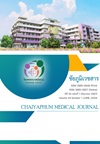Factors related to the treatment of internal fixation in patients with intertrochanteric femur fractures
Keywords:
Factors affect treatment outcome, Intertrochanteric femur fracture, Internal fixationAbstract
Reasons and objectives: To investigate the factors affecting the treatment outcomes of patients with intertrochanteric of femur fracture.
Method: A case-control study was conducted using secondary data from 130 patients aged 50 years and older who had intertrochanteric of femur fracture and were treated with internal fixation surgery between 2020 and 2023 at Pakchong Nana Hospital. The relationship between variables was analyzed using multiple logistic regression.
Results: More than half (61.5%) of the 130 patients had a non-excellent outcome (Harris Hip Score: HHS < 90), while 38.5% had an excellent outcome (HHS ≥ 90). The most common fracture patterns in both groups were AO31-A2.2, AO31-A2.3, and AO31-A1.2. There was no statistically significant difference in fracture patterns between the two groups. Multivariate analysis revealed that the presence of comorbidities (ORAdjusted = 2.04; 95% CI: 1.29, 3.23) and prolonged surgery (ORAdjusted = 1.32; 95% CI: 1.03, 1.70) were associated with non-excellent outcomes.
Conclusion: The presence of comorbidities and prolonged surgery adversely affect treatment outcomes in patients with proximal femur fractures. Strategies to reduce the risk before surgery should focus on three areas: patient preparation, risk assessment for physicians, and the development of screening systems.
References
O’Neill TW, Roy DK. How many people develop fractures with what outcome? Best Practice & Research. Clinical Rheumatology 2005;19(6):879-95.
Maffulli N, Aicale R. Proximal femoral fractures in the elderly: A few things to know, and some to forget. Medicina (Kaunas, Lithuania) 2022;58(10):1314.
Guzon-Illescas O, Fernandez EP, Villarias NC, Quirós Donate FJ, Peña M, Alonso-Blas C, et al. Mortality after osteoporotic hip fracture: incidence, trends, and associated factors. Journal of Orthopaedic Surgery and Research 2019;14(1):203.
กลุ่มคลังข้อมูลสถิติ สำนักงานสถิติแห่งชาติ. “จำนวนประชากรจากการทะเบียน” [Internet]. กรุงเทพฯ: กรมการปกครอง กระทรวงมหาดไทย; 2023 [Accessed on May 2023]. Available from: http://statbbi.nso.go.th/staticreport/page/sector/th/01.aspx
Gullberg B, Johnell O, Kanis JA. World-wide projections for hip fracture. Osteoporosis International 1997;7(5):407-13.
Mundi S, Pindiprolu B, Simunovic N, Bhandari M. Similar mortality rates in hip fracture patients over the past 31 years: A systematic review of RCTs. Acta Orthopaedica 2014;85(1):54-9.
Babagoli M, Raeini AG, Sheykhvatan M, Baghdadi S, Shafiei SH. Influencing factors on morbidity and mortality in intertrochanteric fractures. Sci Rep 2023;13(1):12090.
Fischer H, Maleitzke T, Eder C, Ahmad S, Stöckle U, Braun KF. Management of proximal femur fractures in the elderly: current concepts and treatment options. Eur J Med Res 2021;26(1):86.
Shin WC, Lee SM, Moon NH, Jang JH, Choi MJ. Comparison of cephalomedullary nails with sliding hip screws in surgical treatment of intertrochanteric fractures: A cumulative meta-analysis of randomized controlled trials. Clin Orthop Surg 2023;15(2):192-202.
Feger J, AO/OTA classification of proximal femoral fractures. Radiopaedia.org. 2021 (Accessed on May 2023). Available from: https://radiopaedia.org/articles/94090
Phruetthiphat O-A, Pinijprapa P, Satravaha Y, Kitcharanant N, Pongchaiyakul C. An innovative scoring system for predicting an excellent Harris hip score after proximal femoral nail anti-rotation in elderly patients with intertrochanteric fracture. Sci Rep 2022;12(1):19939.
Jianda X, Homma Y, Jinnai Y, Baba T, Zhuang X, Watari T, et al. Relationship between Charlson comorbidity index, early recovery and 2-year mortality in elderly patients undergoing surgical treatment of inter-trochanteric fractures: a retrospective analysis. Sci Rep 2021;11(1):17195.
Pan L, Ning T, Wu H, Liu H, Wang H, Li X, et al. Prognostic nomogram for risk of mortality after hip fracture surgery in geriatrics. Injury 2022;53(4):1484-9.
de Souza RC. Pinheiro RS, Coeli CM, de Camargo KR. The Charlson comorbidity index (CCI) for adjustment of hip fracture mortality in the elderly: analysis of the importance of recording secondary diagnoses. Cad Saude Publica 2008;24(2):315-22.
Jo S, Lee SH, Yoon S-J. Clinical outcomes of total hip arthroplasty for displaced femoral neck fractures in patients 80 years of age and older selected by clinical frailty score. Hip Pelvis 2020;32(3):148-55.
De Luca A, Murena L, Zanetti M, De Colle P, Ratti C, Canton G. Should the early surgery threshold be moved to 72 h in over-85 patients with hip fracture? A single-center retrospective evaluation on 941 patients. Arch Orthop Trauma Surg 2023;143(6):3091-101.
Beaupre LA, Khong H, Smith C, Kang S, Evens L, Jaiswal PK, et al. The impact of time to surgery after hip fracture on mortality at 30- and 90-days: Does a single benchmark apply to all?. Injury 2019;50(4):950-5.
Schneider AM, Denyer S, Brown NM. Risk factors associated with extended length of hospital stay after geriatric hip fracture. Journal of the American Academy of Orthopaedic Surgeons. J Am Acad Orthop Surg Glob Res Rev 2021;5(5):e21.00073.
Long Y, Wang T, Xu X, Ran G, Zhang H, Dong Q, et al. Risk factors and outcomes of extended length of stay in older adults with intertrochanteric fracture surgery: A retrospective cohort study of 2132 patients. J Clin Med 2022;11(24):7366.
Kang Y, Liu J, Chen H, Ding W, Chen J, Zhao B, et al. Enhanced recovery after surgery (ERAS) in elective intertrochanteric fracture patients result in reduced length of hospital stay (LOS) without compromising functional outcome. J Orthop Surg Res 2019;14(1):209.
Gomez M, Marc C, Talha A, Ruiz N, Noublanche S, Gillibert A, et al. Fast track care for pertrochanteric hip fractures: How does it impact length of stay and complications?. Orthop Traumatol Surg Res 2019;105(5):979-84.
Downloads
Published
Issue
Section
License
Copyright (c) 2024 Chaiyaphum Medical Journal

This work is licensed under a Creative Commons Attribution-NonCommercial-NoDerivatives 4.0 International License.





